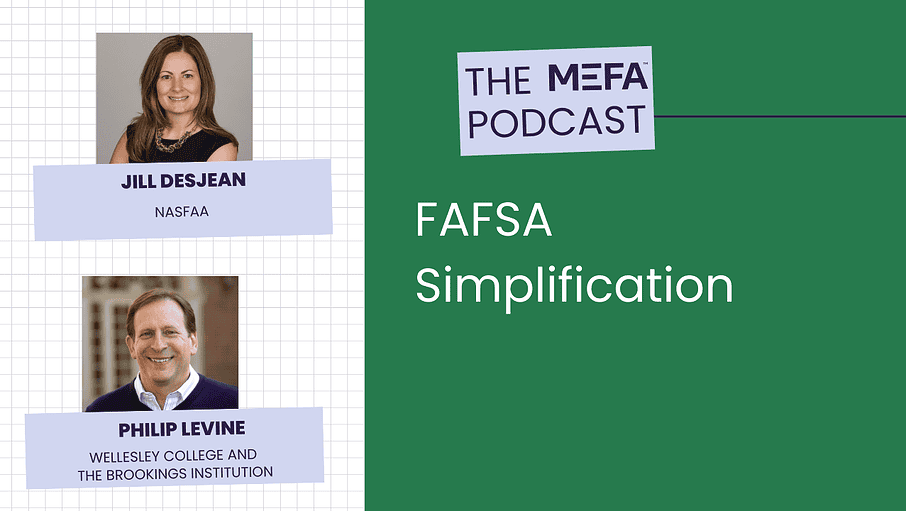

Resources Mentioned in this Episode
Jonathan Hughes: [00:00:00] Welcome to the MEFA Podcast everyone. My name is Jonathan Hughes.
Julie Shields-Rutyna: And I’m Julie Shields -Rutyna
Jonathan Hughes: And we have, as always, a great show for you today. This is very exciting. Today we are talking about FAFSA simplification, and I know that doesn’t sound exciting, but believe me. It’s a big deal. So the, the reason it’s a big deal is that the FAFSA, if you don’t know, is the Federal financial aid form.
It stands for the Free Application for Federal Student Aid and basically everybody who wants financial aid has to file it. You know, if they want financial aid from the Federal government or the State government or from the colleges, they need to file a FAFSA. And it is being radically changed for the first time in decades. Simplified. And it has big implications for [00:01:00] everyone. Isn’t that right, Julie?
Julie Shields-Rutyna: Absolutely. And last week Jonathan and I talked with Jill Desjean from NASFA, the National Association of Student Financial Aid Administrators and Philip Levine from Wellesley College. They’re the authors of a Brookings Institute report on the potential impacts of the FAFSA, changes to families, and a really, really important conversation for anyone who has students who’ll be going to college soon and even.
More so maybe for students who are already in college and will be returning next year. So, before we get to that, let’s talk about something else first.
Jonathan Hughes: Yeah, let’s talk about the UPlan. Okay. So this is a good time of year to talk about the UPlan because you have until July 14th to get your contributions into the UPlan this year and lock in a percentage of this year’s tuition of mandatory fees.
And we’re going to get to what that means exactly. But just the other day I hosted a [00:02:00] webinar on answering questions about. The you plan and you, Julie, are a UPlan customer, or were congratulations on your daughter’s graduation.
Julie Shields-Rutyna: No, thank you. And you’re right, were, because it’s all gone and she graduated last week and that’s, that’s a great thing.
Jonathan Hughes: You’re not paying any more college tuitions. Right? It’s a really good thing. So I thought I would quiz you on some of the questions that I got on this webinar, but before we get into the questions. Can you just, and I know this is a tall order, it sounds simple, but can you just describe the UPlan to anyone who is unfamiliar with it?
Julie Shields-Rutyna: So, sure. The UPlan is the Massachusetts Prepaid Tuition Program. So what does that mean? You could save money today that buys a percentage of today’s tuition and mandatory fees at each of the participating colleges in Massachusetts. And then you carry forward that [00:03:00] percentage in the future for when your child goes to college and tuition prices have increased.
So it’s good to have an example because this can sound complicated, but let’s say you have a child who will start college in 2040. So he or she is a baby. And so you open a u Plan account this year and you put in a thousand dollars. So that will buy 10% of tuition and mandatory fees at a college that costs 10,000 this year, for example.
And it might be 5% of tuition and mandatory fees at a college that costs 20,000. So each college will have a different cost, so your contribution will be worth a different percentage at each one. So then fast forward to 2040 when your child is going to college, and let’s say that that first college that cost 10,000 and you bought 10% of tuition. Then you have [00:04:00] 10% of whatever tuition and mandatory fees are in 2040. So it will probably go up. So if tuition has gone up from 10,000 to 30,000, by that point, your 1000 has become 3000, and that’s, that’s how the UPlan works.
Jonathan Hughes: What happens if the student doesn’t end up participating? One of those participating colleges?
Julie Shields-Rutyna: Yes, and, and I’ll, I always like to begin this question to say that I have two children, and they both went to college and they both went to college outside of Massachusetts, so they didn’t go to a participating institution. So I know this, this piece well, so if that happens let’s say your first student doesn’t go to a participating college and, and let’s add that there are a lot of colleges.
Jonathan, what’s the number out of this? About 70. About 70? Yeah. Yeah. So. If, if that student doesn’t go, you can, you could, you could hold on [00:05:00] to that for a little bit and then, you know, use it for another child within your, your own family. Or if you decide, okay, like in my case, neither child went to a participating institution, so I just cashed out and what I got back was the amount I put in plus interest that had accrued over all of those years.
And then I was able to take that amount and pay the college bills at the colleges they did go to. What is the interest? Yeah, so the interest is CPI and that’s the consumer price index. So let, let’s just talk about the actual investments. People can open an account all year round and contribute. To it throughout the year, but in August, MEFA does the annual bond purchase.
So we take all of the money that you contributed throughout the year and purchase your UPlan certificate. So the minimum to purchase a certificate is $300. So you [00:06:00] have to have at least that amount in your account to lock in a percentage of tuition and mandatory fees. And then your contributions are invested in general obligation bonds that are backed by the full faith and credit of the Commonwealth of Massachusetts. And they accrue interest at that CPI rate.
Jonathan Hughes: Right, and so the annual bond purchase is in August. People usually have until July 15. 15 July 15th. It’s the 14th this year because the, the 14th is Friday to make their contributions for the year. But we don’t take contributions for the plan for about two weeks in mid-July to the beginning of August because that’s when we are doing the bond purchase.
But after that, you can make contributions again. And that’s why I said, people have until July 14th to lock in this year’s tuition in the UPlan.
Julie Shields-Rutyna: And that’s, that’s one of the big differences between the UPlan and the UFund, is that the UFund is the Massachusetts 529 Plan, and that’s also a MEFA program.
And that is [00:07:00] invested in the market and the UPlan is not invested in the market. So I’d just like to point out that that’s, that’s a difference as well.
Jonathan Hughes: Let’s go to one of the questions that I got during that webinar. Can the UPlan be used for trade school?
Julie Shields-Rutyna: So, no, it can’t lock in tuition and fees for a trade school because it really has these seven 70 or so participating institutions and, and they aren’t to trade, you know, they aren’t trade schools, they are colleges and universities.
But if that’s what ends up happening, if your student chooses to go to trade school, which is great. You can cash out and get what you put in plus that CPI interest and then use those funds to pay for the trade school.
Jonathan Hughes: So are there tax implications from cashing out?
Julie Shields-Rutyna: So we always have a caveat when we, you know, talk about taxes because we are not tax professionals and you should definitely consult your [00:08:00] tax preparer with any tax questions. However, cash outs don’t trigger any tax paperwork, so it’s our bond council’s opinion that there are no commonwealth or federal taxes associated with you. Plan distributions.
If you live in another state, it might have some different laws. There may be some tax forms that get generated for different reasons. If you have a certificate that matured and you’re holding onto it for later use, and that post maturity interest accrue, you know, is over $10 in a given year, it might need to be reported on a 1099 to you.
But if, and how that affects your taxes depends on your circumstances.
Jonathan Hughes: All right, well there is, as you can probably tell, so many more things that we can talk about with the UPlan, but we just don’t have time. If you want to hear me talk about the things we couldn’t get to check out the link to my webinar.
It’ll be in the show notes. Or you can go to mefa.org [00:09:00] and search under the videos tab to find the recording. Now as if you haven’t already answered enough questions, Julie, it’s time for the MEFA mail bag. These are taken from questions that have come into us over the past weeks and have been answered by our college planning team.
Now remember, if you have any questions, you can email us at [email protected]. You can call us at 800-449-MEFA and you can reach us over social media on Facebook, that’s @MEFAMA. On Twitter, it’s @MEFATweets and on Instagram, it’s @MEFA_MA. Today’s question comes to us from Stephanie who writes, well, nice compliment at first.
I really appreciate all the videos, webinars, and graphics you provide for those of us who have kids about to apply to college. Well, thank you. Thank you, Stephanie. I have some questions about letters of recommendation. Do colleges have specific guidelines about what has to be in the letter? Or will a teacher already know what to write about? Where does it get [00:10:00] sent? Does the student have access to the letter? Good questions. I don’t know some of the answers to these questions. What do you think, Julie?
Julie Shields-Rutyna: All good questions. So colleges have specific guidelines about how many letters of recommendation need to be part of your application. So that’s one thing I would say.
It’s usually between, if they require a recommendation, it’s between one and three. And I would say follow the guidelines. Don’t send, if they ask for two letters of recommendation, do not send five because they may just read two and then you don’t have control over which two they read. So follow the directions on each college’s website.
They will talk about this is what’s required for admissions. They, don’t necessarily have specific guidelines. Some colleges may put the guidelines out there, some may not. But what they really want to know is from a teacher, an adult that knows the [00:11:00] student well, they want to know what.
What, that person can share about the student’s academic ability skills, strengths, what they will bring to the institution. That’s generally, what they want to know. Sometimes some colleges may have very specific questions for, are a teacher to answer and some might be more general, but that’s generally what they want to know.
And so I think what’s really important, generally, colleges like to receive letters of recommendation from recent teachers. Perhaps junior year teachers in the main core subjects of English, math, science, foreign language history. But there can be exceptions because another important thing with these letters of recommendations is it should be, should be an adult that knows the student well and can really share some great [00:12:00] insight.
So those are some of the things. It gets sent as part of the admissions application. So if a college say, uses the common app for their, you know, admissions application, then the letters are part of that process. So students should definitely pay attention to the admissions guidelines on the, on the college websites.
Pay attention to whatever. If they’re using an application like the Common app or one of the other applications where you can complete an application and send it to many schools, just follow the guidelines on there as well as follow the guidelines of your own high school. So high schools usually have a process in place of a time of the year.
Maybe that’s around April of Junior year, where you can take a form. And ask for a teacher to be your recommender and your, your high school counselor can help you with that as well. [00:13:00] And teachers generally do know what what is needed for these letters to the colleges. And then the last question, does the student have access to the letter?
The answer is no. In some ways, because these letters go directly from the teacher, from the recommender, to the college through. Whatever process. However, sometimes a teacher may give a copy to the student just because they have that relationship and they feel comfortable doing that. But in general, the process is that know the letter goes directly from the recommender to the college.
Jonathan Hughes: All right, Julie. Well thank you so much. One more time. Remember, if you have any questions, you can email us at [email protected]. You can call us at 800-449-MEFA. Our Facebook its @MEFAMA, Twitter @MEFATweets and Instagram @MEFA_MA. We have a bench of college guidance experts waiting to answer your question.
Now, let’s talk about how much the changes in the FAFSA and the financial aid [00:14:00] formula may affect you. Our conversation with Jill Desjean and Philip Levine is up next, filing a FAFSA. The free application for Federal student aid is probably the most crucial and the most universal step in in the whole financial aid process.
The form is filed by about 20 million students every year, and it’s probably the first thing that families learn about when they’re attempting to qualify for aid. So the news that Congress was simplifying the FAFSA form in a push to make it easier for students and families to complete. Is big news with wide ranging implications for students, families, and for colleges.
The new simplified FAFSA debut is this December, and here to help us anticipate what this could mean for everyone involved are the authors of a brooking ins. To study called the Complication with FAFSA simplification. Jill Desjean is the Senior Policy Analyst [00:15:00] at the National Association of Student Financial Aid Administrators, or NASFA as we know it.
Philip Levine is the A. Barton Hepburn and Catherine Coleman, professor of Economics at Wellesley College, a research associate at the National Bureau of Economic Research and a member of the National Eco Academy of Social Insurance. He also served as a senior economist at the White House Council of Economic Advisors.
Jill and Phil, welcome to the MEFA Podcast. Thank you so much for being here. So get right into the first question. I mentioned FAFSA simplification. So tell me how was the form simplified? What do they mean by that, and what are some of the biggest changes that comes to the application?
Jill Desjean: Yeah, I can grab this one. The, the form is significantly shorter than it was before. I don’t know if any of you have had the pleasure of filling out a FAFSA. I have spoken to Phil about that. I know he has. I know my dad did it for me and he became like the expert. He was a firefighter and he did it for everybody else when their kids went to college.
It’s [00:16:00] very long. Asked a lot of complicated questions about your income. In some places you have to sort of look at your tax return and add line one A plus one B and subtract one Z or something. You know, just, you know, it, it’s not something that you just sit down and fill out casually. You need some time.
And so the biggest thing is the, with the FAFSA Simplification Act is that it’s leveraging a law that was passed the year before the FAFSA Simplification Act called the FUTURE Act. Which allows for direct transfer of federal tax information from the IRS to the Department of Education. So essentially what it does, it lets the Department of Education not have to ask any income questions on the fafsa, and those are the hard ones.
So applicants will be providing demographic information. Behind the scenes information will flow from the IRS. It’s going to tell the Department of Education’s, you know, system, their logic, what needs to happen next. And students will be presented with a sort of like a customized faf and their skip logic built in that says, this person doesn’t need to answer this question because they put this certain profile.
So some [00:17:00] people will literally only enter demographic information. Submit it and be done. Other people might have to enter some asset information if they’re higher income and have other identifiers that indicate that they might be people who are likely to have assets. But just a, a much simpler application to complete with fewer questions, more accurate as well, because the information is not coming as a self-report, but right from the IRS.
Julie Shields-Rutyna: Let’s talk about eligibility. So most families, understandably, are concerned about. What they’re going to have to pay. And so we first, I think we have to understand, you know, what is eligibility and you know, what does the FAFSA measure? And so if you can explain the role that eligibility plays in the financial aid process, that would be very helpful.
Jill Desjean: Yeah, that is a surprisingly complex thing. You know, you felt your FAFSA you get your EFC, but then what does that mean? What do they do with that? And so eligibility for student aid is based on the total cost at an institution, which of course vary [00:18:00] from school to school. It’s their tuition and fees, but then it’s also these estimates for living expenses, transportation, books and supplies, bunch of other things.
So it’ll vary from school to school, but you start with that cost of attendance. You subtract out what’s called the Expected family contribution or the EFC, which will change next year to a new name called the Student Aid Index or the SAI. So probably use those terms interchangeably throughout, but know that I’m talking about the same thing.
COA minus EFC or SAI equals a student’s need or otherwise known as their eligibility for financial aid. It is not necessarily the amount of financial aid that you will receive. It represents the maximum amount of eligibility that you could get. But of course, different resources. Federal student aid is limited. State financial aid is limited. Institutions have different levels of resources, so they’re not able to provide grants to necessarily meet a student’s full need. But at least that’s how eligibility is determined.
Jonathan Hughes: So how will this affect then students’ eligibility? Because that not just eliminating questions, but the actual [00:19:00] calculations, the formula’s a little bit different.
Jill Desjean: That’s right. Yeah. So there are in addition to the changes to the fafsa, there are all of these changes to the actual formula, what’s called the Federal Methodology formula. And it’s where all this data that people enter on their FAFSA or in the future will come from.
The i r s sort of flows through this pretty complicated formula that Congress developed to deliver this final EFC, or, you know, as I mentioned before later, SAI. As your EFC is higher or your SAI is higher, you’re eligible for less financial aid because COA minus EFC equals need as your EFC or SAI is lower, you’re eligible for more financial need, financial aid, pardon me. And so this new SAI formula is a more generous formula overall. One of the big things that it does, a couple of big things that it does. One thing is that it as I mentioned earlier, doesn’t ask everyone about assets. So that’s always been the case for some people, but that group of people has actually expanded a bit.
So people who make less than $60,000 won’t be reporting assets because [00:20:00] it’s been found that they’re not likely to have significant assets that would affect their eligibility for financial aid. They’re also more allowances against your income. So bigger chunks of your income are protected in the formula. So basically just never even looked at. And so those things tend to, for most people, lead to an SAI that is lower than what their EFC would’ve been. And so that will likely result for those people in greater eligibility for financially aid than they would experience under the current formula.
Jonathan Hughes: And Oh, I’m sorry. Quick follow up, but just to explain. Because I do, we get questions from people filling out this form all the time. Right. So people want to know if they’re given an, a chance to skip asset questions, for example, right? You said there’ll be fewer people who will be asked to report assets. That’s a good thing for them, right?
Jill Desjean: That’s right. That’s right. Okay. Yeah. You know, in most cases they probably don’t have assets or, you know, the reason they don’t have to report them is that it’s just been found that typically they don’t have them. So they may just be small enough that they are, they [00:21:00] don’t become a, a relevant factor in the end result.
But for a family, you know, d different families have different financial situations. You know, a not uncommon situation might be a family where one parent has died and so there’s been a large life insurance payout, and so they might be a relatively low income family because they have one income earner. They might have significant assets. Those families might actually be exempt from reporting their assets because their income is so low. So people like that could really benefit from this new formula.
Julie Shields-Rutyna: And I have a, a little bit, just a small point, but you were talking about expected family contribution, EFC and Student Aid Index, SAI for the future. Is there a reason that was done? Was it just a name change or is the change more meaningful? Does it have any significance?
Jill Desjean: Yeah, it’s, it’s just a name change, but it is a very important one. You know, this idea, this terminology, expected family contribution, people not unreasonably would hear that and think, oh, that’s the amount I need to pay for college.
And that 100% is not true. [00:22:00] It was always, you know, sort of a rationing thing. It was an index. It was a way to be able to figure who has more need for financial aid and who has less need for financial aid. But of course when you have family contribution in the name of it, people think that’s what I have to pay.
We’re very confused when they were talking with financial aid offices and when they got their bills to say like, this doesn’t look anything like what my EFC looked like. They’re just, the tie to that just didn’t really make any sense. And so this new name, this student aid index, just for accurately to reflect what it is.
It’s an index. It just sort of measures your family’s financial strength. If your SAI is higher, the assumption is that your family has greater resources to pay for college. If your SAI is lower, the assumption is that your family has fewer.
Julie Shields-Rutyna: And I agree for, from talking with families over many years. I think, I think this will be a little bit easier to explain. Awesome.
Jonathan Hughes: Can we talk then branch out a little bit more and talk about one of the differences between the SAI and the EFC, which is the ability to have a negative SAI? Yes. Can you talk [00:23:00] about what that means and why that change was made?
Jill Desjean: Right now the lowest your EFC can be is zero. And so obviously plenty of people who have low incomes, if you did the straight math and came up with your end result before just setting it at zero, you would be negative. And so it is a way of just sort of breaking out by allowing the EFC to the SAI to go to negative $1,500, sort of breaking up that log jam of zeros and showing who the people are, who are, you know, even needier than that.
Of course now you just have this artificial grouping at negative 1500, but then you’ve got some people who sort of are in the, in the middle there. It’s not necessarily going to result in additional financial aid for students. It can but students are still capped at the cost of attendance as the maximum amount of financial aid they can receive.
So, you know, if you were thinking about that COA minus SAI equals need. You would think, oh, you could get $1,500 over your cost of attendance and financial aid. And the Department of Education has come out and said that they do not interpret the law to say that. So they are not going to allow [00:24:00] students to receive more than their cost of attendance.
But that doesn’t mean that they might not get a little more, if they hadn’t had their need fully met up to their COA. And I think more than anything, I think it’s going to help schools to identify who their needy students are, so that if they are trying to give out limited resources to the absolute needy students, they will better be able to identify people, to look at people who are below zero, not just the people who followed zero.
Jonathan Hughes: I want to just keep, put that for just a second if I can, because I want to make sure I understand it and I want to make sure that family’s listening to this when I’m, okay, so let’s say I’m a zero EFC. Student that they did the calculations based on my income and all that stuff. They said, I, my expected family contribution was zero.
And I go to a college that costs $20,000. Right? So that means cost of attendance. 20,000 minus zero is my eligibility. So I’m eligible for $20,000 in financial aid. So if my new EFC is now nega-, my SAI [00:25:00] now goes down to negative 1500. You’re saying my eligibility is still 20,000, is that correct?
Jill Desjean: Yeah, it, it’s tricky. It, it’s, I would say your need is $21,500. Your eligibility is $21,500, but the school isn’t allowed to give you more than 20. But yeah, you know, if you’re doing the straight up math, it’s like, yes, your need is $5,000 higher. It’s just that schools aren’t going to be allowed to give financially aid that high.
Jonathan Hughes: But if there was room sort of like unmet need, I would be able to increase that amount. Is that right?
Jill Desjean: Okay. Right. Yeah. So if a school only gave you say, $15,000 of aid out of that $20,000 cost of attendance, they could bump up by $1,500 and still have room unmet need to be able to fill.
Jonathan Hughes: I see.
Philip Levine: And most schools don’t meet full needs, so that would be appropriate in those situations.
Julie Shields-Rutyna: As the word has gotten out about these changes. One change we have a lot of people talking with us about, and that’s the elimination of the sibling discount, I’ll call it. And you know what that is, [00:26:00] but that in the past when people had two students in college at the same time, the formula treated them a little more generously. . And that’s going away. So can you talk about the rationale for why that’s going away?
Jill Desjean: Obviously I wasn’t in the room where it happened, so I don’t know the rationale. But you know, presumably I think the idea behind that was Congress, one piece of FAFSA simplification was to make Pell Grant eligibility more transparent, more predictable just simpler overall. And so Pell Grant eligibility right now is tied directly to your EFC and moving forward, Pell grant eligibility is going to be based on just your income and your family size. And to have this number in college complication, they wouldn’t be able to easily let somebody just enter a couple of data elements and figured out whether they would get a Pell Grant or not.
And so I think it was really most of, mostly just a, a simplification initiative. It wasn’t that, you know, people [00:27:00] with more than one kid in college at the same time or, you know, Getting a deal they shouldn’t get or anything. I don’t think it was philosophical. It was really mostly about just making Pell Grant eligibility more transparent and the way to do that was to get rid of the, that extra number in college piece.
Philip Levine: I actually think we could. So I agree with all of that, but I also, I think you probably could make a personal finance argument as to, as to why that change was made. You know, as, as if you think about it, you know, you have two children costs a lot of money to raise children these days. And you know, does it really matter that much if they’re, if you have twins and they’re both in college at exactly the same time all four years, or whether they’re four years apart going consecutively, you know, It costs a lot of money either way to raise, to raise those children. And so, you know providing a discount a reduced rate to one of them because they’re twins, you know, may not necessarily reflect the finances of the household.
Jonathan Hughes: Yeah, yeah, that’s a good point. And that, you know, [00:28:00] that brings me to my big question about the study essentially, which is, you know, and you already mentioned that you, you, you looked at the comparative student aid indexes versus the current expected family contributions and how the changes in the formula would, would impact people in college now going, you know, having their EFC versus their upcoming SAI what can you tell me about the differences? In the formula between people going, you know, versus the EFC and the SAI without siblings in college and then with siblings with more than one child in college at at once. What did the differences there look like?
Philip Levine: Yeah, so these big differences I think, you know, so, so my role in this project was, I’m the numbers guy. So I took all of Jill’s, incredible knowledge on the financial aid system and just Plugged it into my computer and just ran a bunch of numbers. You know, I just wanted to see like, you know, how much are people’s you know, prices, what they’re going to have to pay their net prices? How [00:29:00] is that going to change?
In the new system and you know, I think that there’s pretty big changes that are coming along that I think people don’t necessarily know about. I think that you know, so in some sense we, we built a simulator that sort of takes a person through the income distribution. If you start off at zero income, what happens is if you slide that scale up what happens to how much people are how much financial aid people are likely eligible for, which again, as Jill said, is not necessarily how much aid they’re going to get, it’s how much they’re eligible for.
And you know, the first thing that you see is that for the lowest income households under say 30 or $40,000, all of this is assuming typical assets. There really won’t be a whole lot of change because those students were already eligible for the maximum Pell award and they’re still going to be eligible for the maximum P award.
So not, so not that much is going to change for that group. When you move into the next income range, 30 40, you know, into 50, 60, $70,000. That is the P eligible group where you go from maximum P, eventually down to zero P. [00:30:00] Those students are all going to get an increase in their P awards. And those P those increases could be substantial in the order of 2,500, $3,000 could be a lot. That will eventually fade out as your income rises a little bit further. But beyond that, it’s not about Pell and Federal aid, it’s about institutional aid. And many institutions offer additional resources in terms of financial aid to students whose incomes are higher than, you know, 70 or $80,000.
And for students without siblings, their aid eligibility will, will again increase on the order of maybe three, $4,000. Like will meaningful significant increases in the amount of aid for which these students are eligible for. So all of that is likely to be true for students who know siblings for students with sib, with siblings in college at the same time.
That’s not necessarily true. And it’s because of this change in the sibling discount policy that we [00:31:00] just discussed. So for those students, you know, really through P eligibility, you know, they might not get the increases that students without siblings have siblings in college, but they won’t really be harmed either.
It’ll be sort of a wash, you know, roughly speaking, it’ll be a wash. It’s when you go beyond that into institutional aid and the institutional aid. Could be significantly reduced. Eligibility for, in institutionally aid could be significantly reduced for those students on the order. You know, at this point we’re talking like thousands of dollars.
Depending on where you are in the income distribution the cost of attendance at the school you’re attending those students could be paying, could be eligible. For a lot less aid and depending on institutional policy, could be paying considerably higher rates next year than they do, or in the following year than they, than they will next year.
Julie Shields-Rutyna: So what do you think are some decisions colleges will need to be thinking about right now in the wake of these changes [00:32:00] and planning for, to plan for these changes?
Jill Desjean: I think that the biggest one is, is how they’re going to treat the, the people with multiple children in college at the same time for the, the continuing students.
Right. You know, when you think about your student who’s arising sophomore, you know, going into junior year, I, I don’t think any schools want to just say, oh, hey, you’re eligible for $10,000 less than financial aid. You know, we hope that’s okay. No one’s going to want to have those conversations for one thing.
And it’s also just, it doesn’t feel right to do, you know, just because Congress made this decision, it makes perfect sense for people, you know, coming into college. Like this is just the way things are. Now, I say this as a person, I’m going to have three kids in college at once, and even I’m okay with this policy change.
You know, I don’t think the old way was necessarily fair. I don’t get discounts for anything else, you know? But I think that, you know, to level off that eligibility, cliff institutions are probably going to be using their institutional aid dollars to legacy in the old number in college policy. As best as they can.
They still have to comply [00:33:00] with Federal. Rules as far as not giving students over awards. So you can’t just give a student a bunch of institutional dollars because then it makes them ineligible for the federal student aid. But schools with enough resources might even do that. Might just say, you know, we will ignore the Federal aid for the student and just give them a really solid institutional aid package that makes up for this, you know, dramatic shift in eligibility. So I think schools are just still modeling that out. They’re still trying to figure it out. So I haven’t really heard a lot. I know they’re having the conversations, but you know I wouldn’t expect that a lot of people would just suddenly have a rug pulled out from under them if they’re going from, you know, if they’re continuing students and still enrolled in school.
Philip Levine: So in the economics literature, what sometimes people worry about is other institutional incentives. To do things like, you know, if they’re going to get, if students are going to get larger Pell Grant awards institutions can raise tuition at the cost of attendance in order, you know, to gain greater revenue for themselves.
And it helps the institution and not the student. That clearly is an incentive that [00:34:00] people talk about. It’s called the Bennett Hypothesis. It’s been around for a long time. You know, obviously we don’t know what schools are going to do when this new policy comes along. What we do know from past examples of increased generosity in the Pell Grant system. You know, there’s not really like a ton of evidence that supports that. Schools really do that. I mean, so maybe it’s the case, maybe likely to be the case that, that we, we can expect to see that again. But of course until it happens, we won’t really know.
Jonathan Hughes: What do you expect? Or what, what do you gather is the, the general vibe in financial aid offices?
Jill Desjean: Financial aid administrators are pretty overwhelmed right now. This is a lot of change coming all at once. And even though we’ve had a couple of years to prepare financial aid offices are actually pretty understaffed right now.
We’ve been we pull our financial aid administrators every year and we’re finding that staffing shortages are, you know, Started out during the pandemic and are still very much in place. People retired early, people moved on. They’re having a really hard time just, [00:35:00] you know, maintaining their staffing levels to be able to do the level of work they have now.
So they are trying to think about just communication plans to their families. The FAFSA is coming out a couple months late this year. It’s always out on October 1st. It’s not coming out. And so, Sometime in December because the Department of Education actually needs more time to be able to incorporate all of these changes that financial aid offices will then also have to do on their campuses.
So they’re worried about the, this, you know, shift in their whole cycle and how they’ll be able to, to manage that both workload wise. And then both, just, also just, you know, communicating with students, making sure they make the classes and everything else. People are excited. I think that, you know, once this all levels out and hopefully more students will be filling on a FAFSA because it’s easier to fill out yet, won’t be so intimidating. All good things.
Jonathan Hughes: I was at a college. I was at the Boston NACA College Fair, doing a financial aid presentation for students. And really the first one where I kind of talked in any detail about the new FAFSA [00:36:00] s FAFSA simplification and you know, it was for kids 17 year olds, so they were kind of doing their best to pay attention and to financial aid conversations.
I would’ve been the same way, but one of them had a great question. He said, you picked up on it and he said, you said that the FAFSA is being simplified. Is that a good thing? And I said, oh, that’s a really good question. So let me get your answers to it.
Jill Desjean: It’s a good thing. Yeah. You know, I think you know, hopefully it’s, I think, you know, immediately for the people who are going to do it anyway, especially the people who have a kid in college, I think people who really notice, oh hey, this was a lot better.
Or maybe even, especially because they would have like what’s called renewal FAFSA, which is already a little bit easier. But for someone who put a kid through college already, and now their next kid is coming up and they’re filling out the FAFSA, I think they will say, oh, hey, this is so much better than it used to be.
And you know, for if students are filling it up themselves you know, for the, you know, not for the first time, they, they may see that as well. All the hardest questions have been taken off the forum. And so [00:37:00] what I’m hoping in the future, and I’m sure what Congress is hoping was also not just that the people who are going to do it anyway, find it easier, but the people who weren’t going to do it are going to do it.
You know, when you just hear all the time, it, it’s like the conversations about, you know, sticker price in college. You know, college is too expensive. It’s so expensive. There are populations of people who hear that messaging and just think, college isn’t for me. If you hear the FAFSA is so hard, you might think, I, I’m not doing that.
Like, you know, I can’t apply for financial aid. I can’t handle a hard form; you know? And so I think if the message gets out, this is actually pretty easy. You know, you’re entering some really simple demographic information, hitting submit, and then like, here’s your Pell Grant. Hopefully that will encourage more people to apply for financial aid, get into college and finish college.
Philip Levine: And, and I would add to that, that, you know, I, I agree completely with it. That, that this is in general a good thing for a number of reasons. But. There are really important transition issues that just seem like they’re not being handled particularly well. Primarily among them [00:38:00] is just the lack of understanding, the fact that, you know, my guess is that the college fair you were at.
How many of the students that you talked to ever heard of this before you mentioned it, and I guess is the answer is none. And so you’re entering a world in which you’re telling, in which you’ve just instituted a policy that tells kids like college is going to be cheaper for you, maybe thousands of dollars cheaper a year, but they don’t know that like that seems wrong to me. Seems like if you’re going to cut the price and try to encourage kids to go to college, you should tell them. And you know, Jill mentioned that I think one of those struggles in the financial aid offices is finding ways to communicate that message to their current students. But who’s going to tell the 16 and 17 year olds who are still, you know, in line thinking about the process going forward?
Like, we, we need much better outreach. To communicate to them and explain to them that like, you know, this is a good thing. You are, you know, from most of you, you are going to benefit from this.
Julie Shields-Rutyna: No, just thank you. I think anything we can do to add [00:39:00] clarity to all of the communication, which you both just did, is wonderful.
Jonathan Hughes: So thanks. Yeah. Thank you so much for being here. I really did enjoy reading your study, so thank you very much. We’re glad that you could find the time to be here. Thanks for having us. All right folks. Well, that about wraps it up for us. Thanks once again to Jill and Phil for being here and sharing their fantastic work with us.
And if you liked what you heard today and you want to know more about planning, saving, and paying for college and career readiness, well you can follow the show wherever you get your podcasts. And please remember to review us because it helps us. To keep doing what we’re doing and getting this show out to folks like you.
Julie, a heavy lift this week. Thank you very much. It’s great. It’s great. Ah, all right. I want to thank Shaun Connolly, our producer AJ Yee,, for his assistance in posting the show. Once again, my name is Jonathan Hughes and this has been the MEFA Podcast.[00:40:00]













